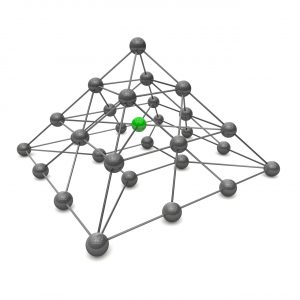On 10.05.2019, the German Accreditation Body published an official notification on the
Inadmissibility of “matrix certifications
published.
How to recognize the erroneous and improper certification practice?
In the case of inadmissible matrix or composite certifications, potential interested parties are regularly offered to “join” or “become a member” of a so-called quality community, an association, a cooperative or another form of company (limited liability company or limited partnership), which acts as a “composite centre” or “matrix centre” and organises the “matrix” or “composite certification”.
The central office of the association regularly provides consulting services to the members, e.g. by making a blanket QM manual available to all members and by carrying out internal audits at the members’ premises or providing a software platform for the member companies. These advisory activities are initially permitted without further ado. However, these self-styled composite or matrix centres claim that by joining their composite, the acceding party is entitled to have its company (as a separate organisation) also be considered certified and to receive a corresponding (sub)certificate; issued to the acceding party’s organisation and for its services to its customers. Thus, for example, it is confirmed by means of a “sub-certificate” that the member, the shareholder or the member of the cooperative as a separate organization also operates, for example, a quality management system according to ISO 9001, although the certification body has only concluded a certification contract with the association or matrix head office. The member’s company, according to the concept, is supposed to be treated as a “site” of the composite or matrix head office.
Another typical feature of the structure is that the corporate purpose (commercial register/register of associations, etc.) of the association or matrix head office is not identical with the corporate purpose or professional profile of the members. For example, the group or matrix head office is usually a consultancy firm or a non-profit association or other non-profit making body and its members are, for example, doctors, lawyers, insolvency practitioners, chimney sweeps or other tradesmen.
It is obvious that a quality management system with the scope of “management consultancy” for the association head office cannot entitle a doctor or a lawyer to confirm the conformity of an effective quality management for the lawyer’s or doctor’s services by means of a (sub)certificate, because for this purpose a completely different quality management system would have to be considered by the certification body.
Such “sub-certificates”, in which the organization and / or the scopes differ between the main certificate and the “sub-certificate”, are always false and misleading in content and violate the ISO 9001 and ISO 9000 standard, completely independent of the question of the defective certification according to ISO/IEC 17021.
What are permissible “multisite” procedures?
According to the DAkkS, however, there is no violation of the normative requirements in the case of permissible multi-site procedures. A permissible multi-site procedure concerns cases in which a company operates various “sites/branches” and applies its (quality) management system uniformly in these in order to provide services to its customers.
In this case, the certification/registration body may, when planning the audit and monitoring the effectiveness of the quality management system in accordance with para. 9.1.5 ISO/IEC 17021 i. V. m. IAF MD 1:2018 perform the on-site auditing of the sites in random samples.
You will find much more detailed information
directly in the official communication of the DAkkS
.
GALLEHR+PARTNER® is at your disposal as an experienced partner of certifiable multi-site or matrix management systems. Here you can find more information about our services.


